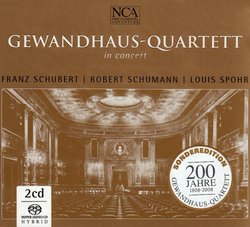| All Artists: Schubert, Schumann, Spohr Title: Gewandhaus-Quartett in Concert Members Wishing: 0 Total Copies: 0 Label: New Classcl Adventure Release Date: 11/4/2008 Album Type: Super Audio CD - DSD, Import Genre: Classical Styles: Chamber Music, Forms & Genres, Concertos Number of Discs: 2 SwapaCD Credits: 2 |
Search - Schubert, Schumann, Spohr :: Gewandhaus-Quartett in Concert
 | Schubert, Schumann, Spohr Gewandhaus-Quartett in Concert Genre: Classical
|
Larger Image |
CD DetailsSimilar CDs |
CD ReviewsThree Wonderful Modern Performances Plus One Recorded in 192 J Scott Morrison | Middlebury VT, USA | 09/14/2009 (5 out of 5 stars) "The Gewandhaus Quartet claims, with good reason, to be the oldest continuously performing string quartet in the world. It was founded by the concertmaster of the Gewandhaus Orchestra in Leipzig in 1808 and over the years has included such famous musicians as Ferdinand David, Joseph Joachim and Julius Klengel. It has always been made up of the principal string players of the Gewandhaus and its current members are Frank-Michael Erben and Conrad Suske, violins, Volker Metz, viola and Jürnjakob Timm, cello. This two-CD set commemorates that 200-year history with three modern performances and a recording made in 1928 of Schubert's Trout Quintet. A nice touch is that all four of the pieces presented here make use of assisting artists -- two pianists (Schumann, Schubert 'Trout'), a cellist (Schubert String Quintet), a bassist ('Trout') and an orchestra (Spohr). One of the modern recordings is of a piece the quartet probably premiered way back in 1845: Ludwig Spohr's Concerto for String Quartet and Orchestra. In this performance the orchestra is, surprise, the Gewandhaus (under its then music director, Herbert Blomstedt). A work I'd never heard before, it is tuneful and pleasantly memorable but certainly no masterpiece. I did enjoy its boisterous finale with its bumptious peasant-dance rhythms.
The 1928 recording of the Trout Quintet sounds remarkably good for its age. There is reasonably good fidelity across the wide sonic range of the piece, with its piano and violins in high register and double-bass rumbling three and four octaves below. Aside from the obviously older recorded sound one telltale sign of its age is the liberal use of string portamenti, a style that soon went out of style. The players are Edgar Wollgandt, violin, Carl Herrmann, viola, Hans Münch-Holland, cello, Theodor Albin Findeisen, double-bass, along with the fabled pianist/teacher Max von Pauer. Interestingly, in 1928 the eminent cellist Julius Klengel, who had joined the Quartet in the 1880s, was still playing in the Quartet, but alternating with the this recording's cellist, Münch-Holland. The Schumann Piano Quintet was premiered by the Gewandhaus Quartet in a house concert in 1842 with Mendelssohn playing (he was sight-reading it) the piano part. The first public performance took place a month later with Clara Schumann at the piano. It has been one of the central works in the chamber music repertoire ever since. In this performance the pianist is the distinguished German artist, Bernd Glemser. This is a forthright, no-holds-barred performance -- just listen to the fugato section of the finale -- that is high on voltage and yet manages to have nuances in its phrasing. My only quibble would be that tempi are slightly inflexible. The highlight of the two-disc set for me is a performance of the Schubert String Quintet, one of the absolute peaks of the chamber literature. The Gewandhaus Quartet is known for its devil-take-the-hindmost playing. Accents seems a bit exaggerated, tone is dense and even somewhat grainy or rough. This is macho playing. At first I didn't know what to make of all this testosterone, but soon became convinced that this is a valid way to play this work. And although the divine adagio is usually played by other quartets with a velvety blend and even ethereality, this performance is somewhat faster than one ordinarily hears and the players, while not taking the greatest care with smooth balances, are utterly convincing. This is, for me, a new approach to one of my favorite works and I am won over. I immediately played the Quintet over, paying close attention, and my conviction that this is a great performance was cemented. On the following day, still not quite able to square my reaction with my own preconceptions of this beloved score, I listened to the whole Quintet again and I was sold all the more. This is a great performance, but it does require throwing out any preconceptions. It was only afterward that I realized that the Gewandhaus was using a similar kind of daredevil approach that they used in their iconoclastic set of the Beethoven quartets, one that I also had to come to terms with before I fell in love with it. Further, I recalled that the second violinist here, Conrad Suske, used to have his own quartet (the Suske Quartet) and that their Beethoven set is also magnificent in much the same way. Scott Morrison" |

 Track Listings (7) - Disc #1
Track Listings (7) - Disc #1![Bruckner:Symphony No. 7 [SACD/CD HYBRID]](https://nationalbookswap.com/cd//m/80/2180/6192180.jpg)